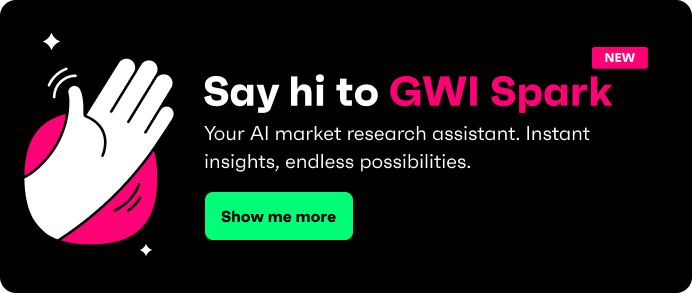
“To be seen is to be known” as the saying goes, but in today’s landscape, showing up more often doesn’t matter too much without some substance behind it. True brand awareness is about being remembered for the right reasons by the right people, and the most effective strategies don’t start with reach. They start with insight.
Whether you’re launching something new, entering a fresh market, or repositioning your brand entirely, consumer understanding is what takes you from top of mind to being trusted. Let’s walk through how to build a brand awareness strategy that’s grounded in reality, not assumptions.
What is brand awareness and why it still matters
Brand awareness used to mean name recognition. And while that still counts, it’s only one part of the story. Today, it includes emotional familiarity, associations, and long-term preference. It’s what makes someone feel something when they see your logo, not just know what you sell.
Done well, awareness creates trust and makes your brand stand out. It’s the start of the entire brand funnel and the reason people choose you over someone else. It’s also what keeps them coming back, talking about you, and becoming part of your story.
Brands with strong awareness don’t just get noticed. They get remembered, recommended, and reselected. That’s what drives growth.
What makes a brand awareness strategy effective today
Reach alone doesn’t cut it anymore. An effective brand awareness strategy goes beyond impressions or headline moments, it’s built on relevance. That means knowing what your audience cares about, where they spend their time, and what language actually lands. So how can you craft a brand awareness strategy that not only makes you stand out from the crowd, but draws them in too? Let’s take a look:
Start with audience-first positioning: Speak to what matters to your target audience, not just what you want to say. Messaging should be consistent, but flexible. A strong brand awareness strategy doesn’t just repeat itself - it adapts without losing clarity.
Tie your creative choices to real behavior: Understand where people are watching, listening, scrolling, or searching and then meet them there with something that feels familiar. It’s all about building that connection.
Shift strategies based on the goal: Launching a product, re-entering a market, or rebuilding trust are all different end goals and so you can’t expect the same strategy to get you to each of them. Segmentation and attitudinal data give you direction, and removes the guesswork that can leave brands stumbling in the dark.
How consumer insights strengthen brand awareness strategies
You can’t build recognition, recall, or relevance without understanding what your audience values. This is where insights come into play to turn awareness into something targeted.
GWI data helps you see who your audience is and what drives them. Interests, behaviors, values - all visible in one place. You can use this to shape messaging that resonates, instead of blending in or getting lost in the noise.
GWI Spark takes this a step further. Ask a question in plain English and get real, survey-backed answers about how people feel about your brand, your competitors, or your category - all powered by AI. Use it to spot gaps, refine positioning, and tailor your strategy by segment or market.
If you want emotional connection, white space, or a clear audience mindset, insight helps you get there faster. And with more confidence.
Building a brand awareness strategy: Step-by-step
Building awareness doesn’t happen by accident, it takes a well thought out plan, backed by data. Here’s how to lay the groundwork with a modern, insight-led approach.
Set clear brand awareness goals
Start by deciding what success looks like for your brand and end goal. Is it higher unaided recall? More recognition in a new market? Stronger brand sentiment? Getting clear now shapes everything that follows.
Define high-potential audiences with consumer data
Don’t stop at surface-level demographics. Use values, lifestyle traits, and behavioral patterns to spot the audiences most likely to care about what you offer.
Craft brand positioning that reflects audience insight
Use consumer insight to look at what your audience actually cares about. What’s overdone? What’s missing? Shape a brand story that speaks to their reality.
Choose channels based on audience habits
Find out where your audience is and how they behave there. Social, streaming, search, or events - context should guide your media choices.
Create emotionally resonant, consistent campaigns
Use emotion to cut through the noise and connect, and consistency to build trust. Your tone, look, and message should all work together, wherever they show up.
Launch, track, and refine based on insight
Don’t treat launch as the finish line. Use tools like GWI’s platform to track sentiment and brand lift. Use those learnings to adjust quickly and stay relevant.
How to measure brand awareness
Measuring brand awareness can feel slippery. But it doesn’t have to be. There are reliable ways to track what’s working, what’s resonating, and where your brand is starting to stick.
Here’s what to keep an eye on, and what each metric actually tells you.
Aided vs unaided recall: Can people name your brand off the top of their head? Or recognize it when they see it? This shows how embedded you are in their mental shortlist.
Brand sentiment and perception: It’s not just whether people know you. It’s what they associate with you. Track the traits and emotions tied to your name to understand how you're landing.
Share of voice: How much space are you taking up in the conversation? Whether it’s media, mentions, or campaigns, this reveals your visibility relative to competitors.
Branded search and direct traffic: These are strong intent signals. People are either looking for you by name or heading straight to your site. Both suggest awareness is turning into action.
Brand lift metrics: These show the before-and-after impact of your campaigns. They’re especially useful when you want to understand what’s actually shifting perception or recognition.
GWI can help you track awareness trends over time by market or audience. Turn to GWI Spark when you need fast, survey-backed insight into what’s landing where. Together, they give you both the depth and speed to monitor brand impact with confidence.
Bring all these metrics together and you’ll have a clear picture of how your brand is performing, where it’s resonating, and where to focus next.
Common pitfalls that undermine brand awareness efforts
Even the best creative won’t land without strategy behind it. Here are some common missteps to avoid when building brand awareness.
- Prioritizing visibility over relevance: Being seen doesn’t mean being remembered.
- Sending mixed messages across platforms: Inconsistent messaging makes it harder to build trust.
- Working off outdated audience assumptions: People evolve. What worked last year might not land now.
- Skipping the strategy step: Launching without insight often leads to noise, not impact.
- Ignoring how people perceive your brand: Without tracking sentiment and feedback, you can’t course-correct or improve.
Every one of these is avoidable with the right audience insight baked in from the start.
Final thoughts: Lead with insight, build with purpose
Brand awareness isn’t just about being noticed. It’s about being known, understood, and trusted. The best strategies don’t rely on luck or loudness, they’re rooted in clear thinking and real audience understanding.
When you start with insight, you build relevance. When you build with purpose, you earn attention that lasts. GWI’s global data, and tools like GWI Spark, help you do both with confidence - and keep evolving as your audience does.
Frequently asked questions
What is the difference between brand awareness and brand recognition?
Brand recognition is the ability to identify a brand based on name, logo, or design. Awareness goes further. It includes familiarity, emotional connection, and understanding what the brand stands for.
How do you create a brand awareness strategy?
Start with clear goals. Use audience data to shape your message and pick the right channels. Build campaigns that resonate emotionally. Then track and adjust as you go.
What are the best ways to increase brand awareness in a new market?
Use local audience insights to guide your creative and media choices. Tell relevant stories, use culturally familiar cues, and show up consistently where your audience spends time.
How do you measure brand awareness success?
Track recall, sentiment, visibility, and direct engagement. Look at changes in search volume, perception, and share of voice - especially within your target audience.
Can consumer insights improve brand awareness campaigns?
Absolutely. Insight helps you focus on what matters, tailor messages by segment, and measure success with more accuracy. That makes your campaigns sharper and more effective.





.webp?width=495&height=317&name=pink_thumb_graphs%20(1).webp)
.webp?width=495&height=317&name=pink_thumb_letter%20(2).webp)